最新M7Mypastlife模板教案.docx
《最新M7Mypastlife模板教案.docx》由会员分享,可在线阅读,更多相关《最新M7Mypastlife模板教案.docx(9页珍藏版)》请在冰豆网上搜索。

最新M7Mypastlife模板教案
Module7Mypastlife教学设计
课题
Unit1Iwasborninasmallvillage.
课时安排
1课时
教学准备
Taperecorder,PPT
教学目标
1.语言知识目标:
掌握下列单词:
born,strict,primacyschool,friendly,village,difficult,bathroom,bedroom,garden,livingroom,coast,east,ago,store,movietheater/,bored,president,lake,lastandcomfortable。
2.语言技能目标:
1)能听懂包含动词be的过去式(was/were)的对话。
2)能用动词be的过去式(was/were)表述自己过去的经历,并能用它询问对方过去的生活。
3)能用动词be的过去式(was/were)描述自己和别人的过去生活和经历。
3.情感目标:
通过对过去童年或家乡的描述,产生对家乡和美好生活的热爱。
教学重点
动词be的过去式(was/were)
教学难点
动词be的过去式(was/were)
教学过程
二次备课
Step1:
Studythefollowingnewwords.
born,strict,primary,primacyschool,town,friendly,US,hey,village,nice,good,difficult
Step2:
Warmingup
Togivesomepicturesandvideosaboutmeandmypastlifetostudents.Letthemwatch.Andthen,talkaboutmyson.Atlast,letstudentstalkaboutthemselves.
Step3:
Workinpairs.Listenandnumberthequestionsasyouhearthem.
Andthen,answerthequestions.Usethewordsandexpressionsfromthebox.
Step4:
Listenagainandcheck(√)thetruesentences.
Step5:
ListenandreadtheActivity3.Andchoosethecorrectanswer.
Step6:
TostudyEverydayEnglish.
Step7:
Completethetable.
Step8:
Listenandnoticethestressed.Andlistenandrepeat.
Step9:
Workinpairs.Askandanswerthequestionsaboutyourpastlife.
Nowtellyourclassmatesaboutyourpastlife.
Andthengivesomeexercisestostudentsaboutthenewwords.
1.Iwas_____(出生)inShandong.
2.Wereyoufromthe_____(城镇)?
3.Thiswasour_____(初级的)school.
4.Motherwas_____(严厉的)but_____(友好的)forme.
5.Theylikethe_____(村庄).
6.LiFangis_____(乖的)butJimis_____(难对付的).
Step11:
Explainandstudytheimportantanddifficultpoints.
1.good
2.beborn
e.g.IwasborninZibo.
3.thenameof
e.g.ThenameofhisschoolisForeignLanguageSchool.
4.bestrictwith对某人严格
e.g.Ourteacherisverystrictwithus.
老师对我们要求很严格。
5.primaryschool小学
e.g.Thechildrenliketheirprimaryschoolverymuch.
孩子们非常喜欢他们的小学。
I.Fillingtheblanksusingthenewwords.
1.I_____inTaiyuanlastyear.
2._____youdifficult?
3.It_____DarwinPrimarySchool.
4.Who_____yourfirstEnglishteacher?
5.They_____borninUS.
II.SentenceTransformation:
1.ShewasMsYao.She_____MsYao.
__________MsYao?
Yes,__________./_____,she_____.
2.Hewasstrictatschool.He_____strictatschool.
__________strictatschool?
_____,he_____./No,_____.
3.Weweregoodinclass.We_____goodinclass.
__________goodinclass?
Yes,__________./No,_____.
Step12:
StudyGrammar——Thesimplepasttense(thepasttenseofverb“be”)
原形
am
is
are
否定缩略式
amnot
isn’t
aren’t
过去式
was
was
were
否定缩略式
wasn’t
wasn’t
weren’t
Step13:
Homework
1.Recitetheimportantpoints.
2.Talkaboutyourpastlife.
教学反思
课题
Unit2IwasborninQuincy.
课时安排
1课时
教学准备
Taperecorder,PPT
教学目标
1.语言知识目标:
掌握下列单词:
born,strict,primacyschool,friendly,village,difficult,bathroom,bedroom,garden,livingroom,coast,east,ago,store,movietheater/,bored,president,lake,lastandcomfortable。
2.语言技能目标:
1)能听懂包含动词be的过去式(was/were)的对话。
2)能用动词be的过去式(was/were)表述自己过去的经历,并能用它询问对方过去的生活。
3)能用动词be的过去式(was/were)描述自己和别人的过去生活和经历。
3.情感目标:
通过对过去童年或家乡的描述,产生对家乡和美好生活的热爱
教学重点
动词be的过去式(was/were)
教学难点
动词be的过去式(was/were)
教学过程
二次备课修改处
Step1:
ShowthenewwordsandexpressionsofUnit2Module7.
bathroom,bedroom,garden,livingroom,coast,east,ago,store,movietheater/theatre,bored,president,lake,last,comfortable
Andthengivestudentssomeexercisesaboutthenewwords.
CompletethesentencesaccordingtoChineseandpictures.
1.Thisisour________(浴室)andthatisa_______(卧室).
2.Thisisa_____(花园)andthatisa______(客厅).
3.Thisisa______(湖)andthatisariver.
4.Thisisanew________(商店)andthatisanold_________(电影院).
5.Ilivedatthe__________(东部海岸)tenyears_____(以前).
6.Didtheir_____(总统)livethere_____(最近过去的)year?
7.Wasyourbed_____(舒服的),Lingling?
8.Themanwas_____(厌倦的)thecomputergames.
Step2:
Warming-upandLeadin
TogivesomepicturesandvideosaboutQuincytostudents.Letthemwatchanddescribethem.
Step3:
Workinpairs.Labelthepicturewiththewordsfromthebox.
Step4:
ReadthepassageofActivity2andchoosethecorrectanswer.
Step5:
Answerthesequestions.
Step6:
StudysomedifferentusagesofBritishEnglishandAmericanEnglish.
Step7:
CompletethepassageofActivity4withthecorrectformofthewordsfromthebox.
Step8:
Writtentask
DescribeyourpastlifewiththeanswersfromActivity6.
教学反思
课题
Unit3Languageinuse
课时安排
1课时
教学准备
Taperecorder,PPT
教学目标
1.语言知识目标:
掌握下列单词:
born,strict,primacyschool,friendly,village,difficult,bathroom,bedroom,garden,livingroom,coast,east,ago,store,movietheater/,bored,president,lake,lastandcomfortable。
2.语言技能目标:
1)能听懂包含动词be的过去式(was/were)的对话。
2)能用动词be的过去式(was/were)表述自己过去的经历,并能用它询问对方过去的生活。
3)能用动词be的过去式(was/were)描述自己和别人的过去生活和经历。
创业首先要有“风险意识”,要能承受住风险和失败。
还要有责任感,要对公司、员工、投资者负责。
务实精神也必不可少,必须踏实做事;3.情感目标:
1、作者:
蒋志华《市场调查与预测》,中国统计出版社2002年8月§11-2市场调查分析书面报告通过对过去童年或家乡的描述,产生对家乡和美好生活的热爱
教学重点
9、如果你亲戚朋友送你一件DIY手工艺制品你是否会喜欢?
动词be的过去式(was/were)
8、你是如何得志DIY手工艺制品的?
教学难点
(2)文化优势动词be的过去式(was/were)
教学过程
手工艺制品是我国一种传统文化的象征,它品种多样,方式新颖,制作简单,深受广大学生朋友的喜欢。
当今大学生的消费行为表现在追求新颖,追求时尚。
追求个性,表现自我的消费趋向:
购买行为有较强的感情色彩,比起男生热衷于的网络游戏,极限运动,手工艺制品更得女生的喜欢。
二次备课修改处
Step1:
Revisionandleadingin
Usefulphrases:
beborn…thenameof….bestrictwith…primaryschool
1、DIY手工艺市场状况分析Givesomepicturesandsentencestopracticeingroup.
Step2:
Languagepractice
Step3:
Workinpairs.ReadaboutLiuYun.Askandanswerthequestions.
Where/born?
—Wherewassheborn?
—ShewasborninTianjin.
(2)东西全1.what/primaryschool?
2.who/firstteacher?
3.who/firstfriends?
Step4:
StudyGrammar——Thesimplepasttense
(1)
(三)大学生购买消费DIY手工艺品的特点分析一般过去时表示过去某个时间里发生的动作或状态;过去习惯性、经常性的动作、行为;动词be的过去时的基本结构:
肯定:
主语+was/were+其他;否定:
主语+was/were+not+其他;一般疑问:
were/was+主语+其他。
图1-5购物是对消费环境的要求分布be动词的过去式:
原形
am
is
are
否定缩略式
amnot
isn’t
aren’t
过去式
was
was
were
否定缩略式
wasn’t
wasn’t
weren’t
学习动词be的一般过去时,下面有一口诀,它可以帮大家更好地掌握动词be的一般过去时。
动词be的过去时有四巧:
一是时间状语巧,表示过去的短语要记牢;二是形式巧,单数was,复数were;否定句结构是三巧,not紧跟was/were;四是疑问句式巧,was/were向前跑(提前)。
【一巧】时间状语巧。
一般过去时表示过去发生的动作或存在的状态,恰巧与表示过去的一些时间状语连用。
例如:
yesterday,lastnight/week/month/year,lastSaturday,thedaybeforeyesterday,in1998,five years ago等。
【二巧】形式巧。
它与一般现在时一样,形式多样:
当主语是第一人称单数或第三人称单数时,谓语动词用was;主语是第二人称或其他人称复数时,谓语动词用were。
例如:
Iwasintheclassroomyesterdaymorning.昨天早上我在教室里。
TheywereatschoollastTuesday.上周二他们在学校。
【三巧】否定句结构巧。
与动词be的一般现在时一样,它在动词后面加not即可变成否定句,并且was,were与not可以缩写成wasn’t,weren’t。
即:
主语+wasn’t/weren’t+表语+其他。
例如:
Iwasnot(=wasn’t)hereyesterday.昨天我不在这儿。
【四巧】疑问句式巧。
把was,were提到句首,句末用问号即可变为一般疑问句。
即:
Was(Were)+主语+表语+其他?
这恰巧与动词be的一般现在时的疑问句式相似。
例如:
Wereyouathomethedaybeforeyesterday?
前天你在家吗?
Wasshelatethismorning?
今天早上她迟到了吗?
更巧的是疑问句的答语也相似,肯定回答用“Yes,主语+was/were.”;否定回答用“No,主语+wasn’t/weren’t.”。
Step5:
Completethesentenceswiththecorrectformof“be”.
Step6:
Workinpairs.Completethesentenceswiththecorrectformofthewordandexpressionsfromthebox.
Step7:
Aroundtheworld——ToknowHeroofSouthAfrica:
NelsonMandela
Step8:
Moduletask——Writingaboutyourclassmate’spast
Step9:
Homework
Writeaboutyourclassmate’spastlife.
He/Shewasborn...
教学反思